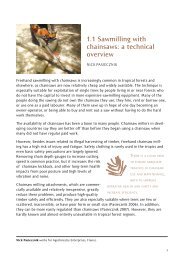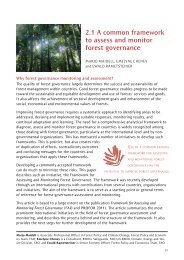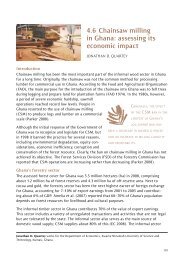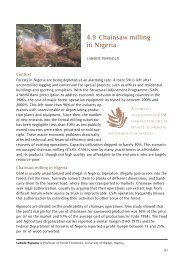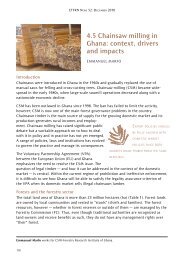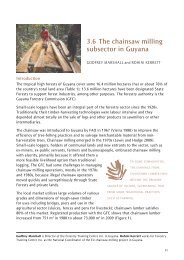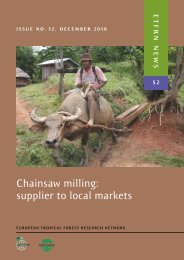Chainsaw milling: supplier to local markets - European Tropical ...
Chainsaw milling: supplier to local markets - European Tropical ...
Chainsaw milling: supplier to local markets - European Tropical ...
You also want an ePaper? Increase the reach of your titles
YUMPU automatically turns print PDFs into web optimized ePapers that Google loves.
3.1 ThE DEvElopmENT oF small-scalE loggiNg iN bolivia<br />
now logs are transported from the forest in the dry season over old or new extraction<br />
roads by small and worn-out trucks. logs are loaded using levers and taken <strong>to</strong> sawmills<br />
in the vicinity. This change is especially predominant in the more accessible areas where<br />
old logging roads enable small trucks <strong>to</strong> move the logs, without substantial investment<br />
required in road construction. Changes in logging techniques and market demand allowed<br />
loggers <strong>to</strong> include tree species that previously had not been logged by chainsaw millers.<br />
<strong>Chainsaw</strong> <strong>milling</strong> used <strong>to</strong> be the main logging technique in bolivia available <strong>to</strong> smallholders<br />
that did not require a large capital investment. since the introduction of the 1996<br />
forest law, the use of chainsaw <strong>milling</strong> has been reduced <strong>to</strong> areas that are difficult <strong>to</strong> reach<br />
(occasionally with the consent of the forest service) and <strong>to</strong> protected areas where logging<br />
is prohibited and high-value tree species are still abundant. in these places, chainsaw millers<br />
still target high-value species for the export market. There is no official information<br />
available on the commercial timber volumes being processed by chainsaw millers.<br />
The 1996 forest law<br />
The objective of the 1996 Forest law was <strong>to</strong> democratize access <strong>to</strong> the forest exploitation<br />
and establish sFm. one of the major changes was that farmers, communities, private<br />
land-owners and people previously involved in illegal logging — as well as private enterprises<br />
— were allowed <strong>to</strong> harvest timber commercially. private and collective land-owners<br />
were granted exclusive forest user rights <strong>to</strong> their land; illegal loggers could organize themselves<br />
in a <strong>local</strong> social association/Asociación Local de Lugar (asl) and request a municipal<br />
forest concession; and private enterprises could convert their old logging contracts <strong>to</strong> new<br />
long-term concessions.<br />
options for forest management were given <strong>to</strong> a range of forest users on both private and<br />
public land at the national and municipal level. an important requirement for all these<br />
forest users was that they comply with formal forest management regulations.<br />
Depending on the size of the forest, the requirements for a forest management plan differ<br />
considerably. Forest areas over 200 ha require a forest inven<strong>to</strong>ry and an extensive forest<br />
management plan. Yearly logging plans and reports are required in order <strong>to</strong> be granted<br />
transportation permits. Forest areas under 200 ha require only a relatively simple logging<br />
plan.<br />
The management system prescribed by the forest law, however, is similar for all forest<br />
areas (i.e., the same minimal cutting diameter, maximum logging intensity and 20-year<br />
cutting cycle). all commercial logging activities (irrespective the size of the forest or logging<br />
intensity) have <strong>to</strong> transport logs <strong>to</strong> sawmills <strong>to</strong> avoid the efficiency losses of using a<br />
chainsaw <strong>to</strong> process timber.<br />
in practice this means that operations require skidders <strong>to</strong> extract the logs, loaders <strong>to</strong><br />
stack the logs on the truck and trucks <strong>to</strong> move logs from the forest <strong>to</strong> the sawmill. roads,<br />
landing places and bridges have <strong>to</strong> be built. These operations all require major invest-<br />
61



